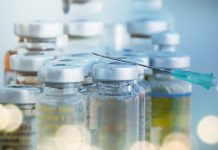A more straightforward, cheaper and still effective method of pre-surgery infection control is underway in Wellington Hospital thanks to a nurse quality project.
The hospital has swapped using an antibiotic cream applied in the nose before and after cardiac surgery – to prevent staphylococcus aureus (staph) surgical site infections – and replaced it with an antiseptic iodine nasal swab instead.
The change to the ‘anti-staph’ infection prevention bundle was initiated by infection prevention and control (IPC) clinical nurse specialist Karen Corban with the support of her mentors cardiothoracic surgeon Sean Galvin and microbiologist Professor Tim Blackmore.
Corban said the project arose when she chose to audit the hospital’s cardiac surgery anti-staph bundle as part of an IPC quality improvement course being offered through the Health Quality and Safety Commission (HQSC) and linked to its national surgical site infection (SSI) improvement project.
Wellington Hospital had introduced an anti-staph bundle two years ago, targeted at reducing cardiac SSIs, that included an antiseptic body wipe (chlorhexidine) and also applying mupirocin (also known as Bactroban) antibiotic cream in the nose before and after surgery.
Corban said the audit showed up low compliance with the mupirocin ointment component of the bundle, which involved applying the antibiotic cream the night before surgery and then twice a day for five days. A brain storming session with ward staff found non-compliance was due to a number of reasons including the cream going missing and not all staff being aware of the need for the twice-daily regime. Staff questioned why there wasn’t something that only needed to be done once to reduce the risk of nasal bacteria causing SSIs.
Looking for an answer she turned to her mentors Galvin, who was part of the HQSC’s group looking at preventing cardiac SSI, and Blackmore, who was leading the DHB’s antimicrobial stewardship project. At the same time late last year HQSC put out an anti-staph bundle discussion paper that examined the latest literature and suggested that an antiseptic nasal swab containing an iodine product could be just as effective as mupirocin. (See related research articles below).
Corban said using an antiseptic rather than an antibiotic was also seen to reduce the risk of patients becoming resistant to mupirocin and meant the antibiotic cream could be saved for when it was needed to fight an infection. Using povidone-iodine swabs to decolonise the nose was also much cheaper with iodine swabs costing around 80c each compared to $50 per tube of antibiotic ointment. Corban said the swabs also reduced the need for some laboratory tests and in total the swabs could save around $100 per patient so the project had already saved about $25,000 since it got underway in January.
Another advantage was that the swabs only needed to be done once – about one to two hours before the patient went to theatre – and provided cover for 12 hours.
So the decision to swap from the antibiotic cream to swabbing from the start of this year was backed by nurses who felt they were being listened to and saw the swabbing as a more practical alternative. She said the move had also been supported by HQSC which was exploring different options for introducing anti-staph bundles to DHBs across the country.
Corban said part of the project was developing a process for carrying out the antiseptic swabbing that including testing it out by inserting swabs up her own nose and the nose of a fellow IPC nurse specialist. “When we taught the process we gave everyone a swab that they could do themselves, or utilise on each other, so they knew what it felt like to be a patient and have that up their nose.”
The swabbing process involves one swab in the first nostril for 30 seconds, followed by another swab for 30 seconds in the second nostril and then repeated with a further 30 second swab to each nostril.
An important part of the antiseptic swabbing was amount of contact time with the mucosa so Corban developed a swabbing technique and pattern that takes 30 seconds to complete so nurses don’t have to keep an eye on a fob watch.
Corban, an ex-cardiothoracic charge nurse, followed up the swabbing training by coming in to the ward 6.30am every morning for five days a week for 20 weeks to observe pre-surgery swabs being given. She then followed it up with two months of observing five swabs a week and now is down to three-monthly checking of swabbing technique.
A staph aureus information sheet was developed for registered nurses plus an information sheet for patients about the process. She also surveyed a 100 patients with more than 90 per cent of them reporting the swab process was neither pleasant or unpleasant and it was found to be well-tolerated.
The DHB does about 550 cardiac surgeries a year but is now looking to roll out the anti-staph bundle to orthopaedic surgery.
Corban, who has a masters in public health, said the success of anti-staph bundle project has also seen her invited by HQSC to join its anti-staph bundle working group.
Further reading:
Discussion paper: Anti-staphylococcal bundle to reduce surgical site infections in orthopaedic and cardiac surgery (November 2016), HQSC
Anti-staphylococcal bundle to reduce surgical site infections in orthopaedic and cardiac surgery (March 2017) HQSC
Beboko S, Green D & Awad S (2015) Effect of a Preoperative Decontamination Protocol on Surgical Site Infections in Patients Undergoing Elective Orthopedic Surgery With Hardware Implantation. JAMA Surg. 2015;150(5):390-395. doi:10.1001/jamasurg.2014.3480
Anderson MJ, David M, Scholz M et al (2015) Efficacy of Skin and Nasal Povidone-Iodine Preparation against Mupirocin-Resistant Methicillin-Resistant Staphylococcus aureus and S. aureus within the Anterior Nares. Antimicrobial Agents and Chemotherapy 59(5)






















Is any testing done before using the nasal swabs to determine if the patient may have an allergy to iodine ?
Karen Corban replies:
“Patients are not tested for an allergy to iodine because iodine is a natural trace element in the human body. The swabs use a 10 percent povidine iodine water-based antiseptic, and it is not possible to have a true allergy to elemental iodine.”